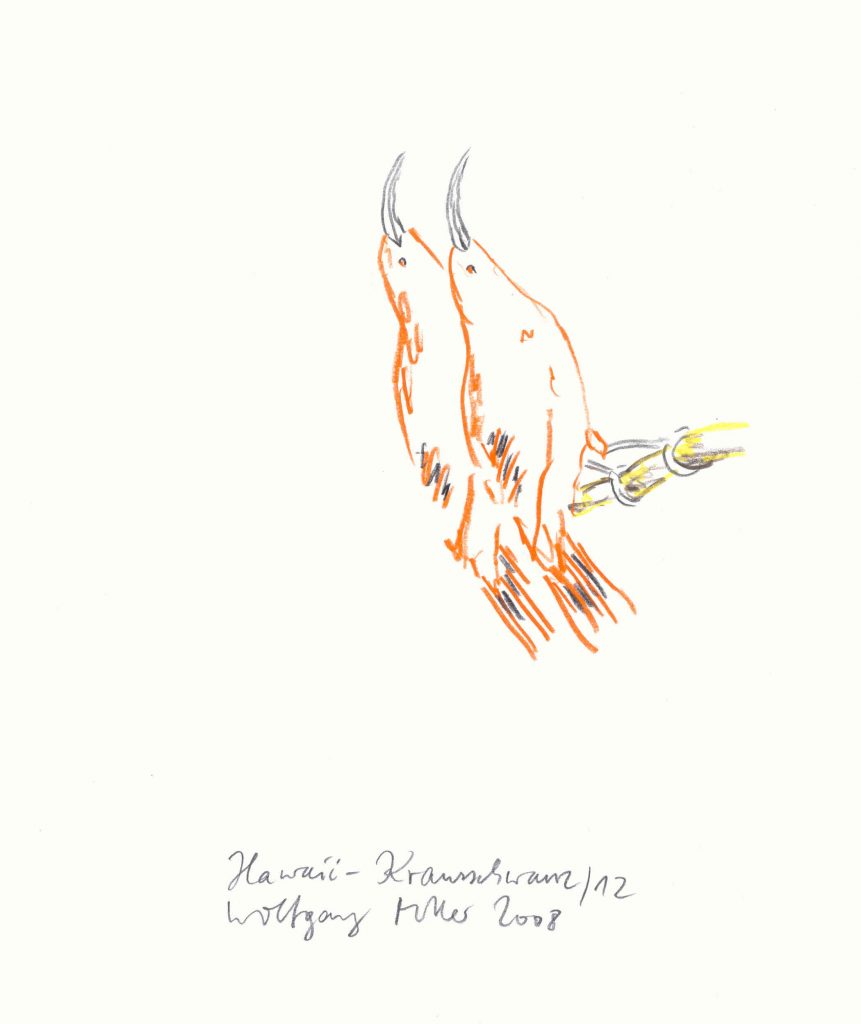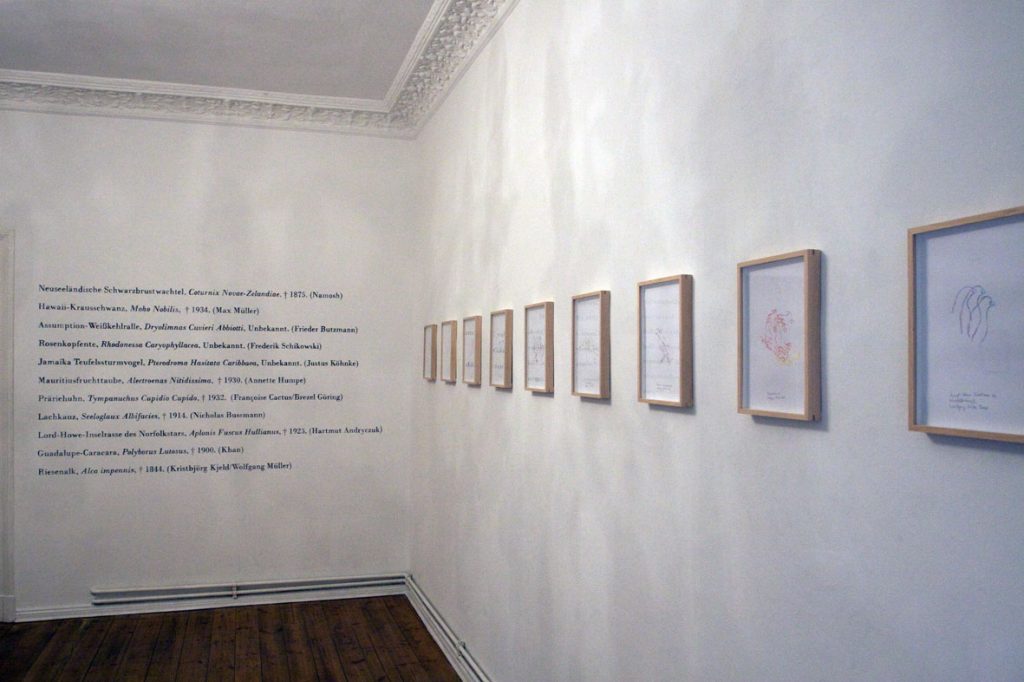Exhibition opening in the Crystal Ball Gallery and the Dörrie Priess Gallery on 25 September at 7 pm
26. 9. – 6. 11. 2009
 Hawaii Krausschwanz, Wolfgang Müller
Hawaii Krausschwanz, Wolfgang MüllerSéance Vocibus Avium (I)
The only completely exterminated bird originally native to Europe is the North Atlantic giant auklet (Alca impennis). Its last occurrence is off the southern Icelandic coast on the rocky island of Eldey. On 3 June 1844, the last two birds, a breeding pair, were killed there by the fishermen Jón Brandsson, Sigurður Ísleifsson and Ketill Ketillson from Hafnir by turning their necks in order to sell their bellows and offal to a Danish bird collector. This silences the bird’s song forever.
After his first trip to Iceland in 1990, Wolfgang Müller formed a giant auk from modelling clay, fabric, paper, paint and chicken feathers. In 1994, on the occasion of the 160th anniversary of its extermination, he reconstructed the bird’s vocalizations in the radio play studio of the Icelandic radio station stöð 2, using the Icelandic actress Kristbjörg Kjeld as his medium. Using modern studio technology, the bird’s calls are reconstructed and thus made audible for the first time since its extinction in 1844. The reconstruction is based on historical scientific descriptions, such as those of Dr. Alfred Newton from Cambridge. In 1854 he asked the sailors from Hafnir about the last minutes in the life of the last giant eagles and published their detailed statements in 1858 in the ornithological journal “Ibis”.
Other bird species, mostly exterminated by direct or indirect human intervention, originate mainly from North and Central America, Madagascar, Australia, New Zealand and the islands of the Pacific Ocean. Since the 16th century, an estimated one hundred and fifty bird species have become extinct. Descriptions of the vocalizations of very few of these exist.
In addition to the giant eagle, ten other bird species are among them, whose calls can now be heard simultaneously in the Galerie Dörrie * Priess and the Galerie Crystal Ball. Wolfgang Müller gave ten well-known musicians scientific descriptions of a selected species and asked the respective participants to leave their bodies and slip into the bird body assigned to them. At the moment the bird becomes a bird, music and musicians disappear. The calls of long-silenced birds resound.
- Coturnix Novae-Zelandiae, Neuseeländische Schwarzbrustwachtel, † 1875. (Namosh)
- Hawaii-Krausschwanz, Moho Nobilis, † 1934. (Max Müller)
- Assumption-Weißkehlralle, Dryolimnas Cuvieri Abbiotti, Unbekannt. (Frieder Butzmann)
- Jamaika Teufelssturmvogel, Pterodroma Hasitata Caribbaea, Unbekannt. (Justus Köhnke)
- Mauritiusfruchttaube, Alectroenas Nitidissima, † 1930. (Annette Humpe)
- Präriehuhn, Tympanuchus Cupidio Cupido, † 1932. (Francoise Cactus/Brezel Göring)
- Lachkauz, Sceloglaux Albifacies, † 1914. (Nicholas Bussmann)
- Lord-Howe-Inselrasse des Norfolkstars, Aplonis Fuscus Hullianus, † 1923. (Hartmut Andryczuk)
- Guadalupe-Caracara, Polyborus Lutosus, † 1900. (Khan)
- Riesenalk, Alca impennis, † 1844. (Kristbjörg Kjeld/Wolfgang Müller)
Séance Vocibus Avium (II)
The corresponding radio play “Séance Vocibus Avium” of the artist just won the Karl-Szuka-Award 2009 – considered the most renowned award for audio art in Europe. In the exhibition Séance Vocibus Avium, taking place in two Berlin galleries – Crystal Ball and Dörrie Priess – Wolfgang Müller presents drawings and audio sounds he produced, based on historical and scientific descriptions of eleven extinct birds. The simultaneous presentation of Séance Vocibus Avium in the context of two different gallery spaces continues Wolfgang Müller’s concept: the synchronism of analogy and diversity. Wolfgang Müller enlisted the help of prominent musician friends: Namosh, Khan, Justus Köhncke, Nicholas Bussmann, Max Müller, Stereo Total, Frieder Butzmann and Annette Humpe- in the reconstruction of the bird sounds. With delicately rendered colour pencil drawings Müller approaches the shape of the lost birds.
His reconstruction process begins with the available materials: taxidermy birds, historical images and scientific descriptions concerning the behavior of the species. The resulting drawings are different for each species, but unmistakably related. Wolfgang Müller opens up a novel space with his work. It stands in a touching alliance to the scientific efforts, to describe and comprehend these no longer existing animals. A new reality is created.
 Séance Vocibus Avium, Wolfgang Müller
Séance Vocibus Avium, Wolfgang Müller